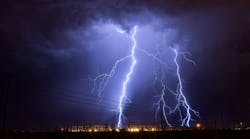Oncor is in an ongoing battle to protect its property. Copper wire thefts occur almost daily from Oncor substations, particularly in urban areas. The Dallas, Texas-based utility understands the only way to stop copper wire theft is to be proactive and fight on multiple fronts. Such thefts threaten the safety of employees and the general public, and are hitting the bottom line. On Oncor's system, many potential copper thieves have been injured or killed from contact with high-voltage lines.
To fight the wire theft problem, Oncor employs several strategies. Oncor marks copper ground wire with paint to assist police in identifying stolen copper, covers exposed grounds with metal guards and a concrete-like product to deter thieves, and works with local law enforcement to find and prosecute criminals.
Calculating the Cost of Copper Theft
Copper wire theft is costly, in more than one way.
In one particular incident, copper theft caused the failure of a 138-kV switch and the destruction of a transformer control compartment, resulting in an enormous amount of repair work and the cost of a replacement switch. With transformer equipment grounds missing, the resulting circulating current not only damaged the equipment but degraded the power quality. In this case, Oncor invested close to $200,000 to get the substation back up and running.
In 2005, Oncor's Dallas district began tracking the financial impact of copper thefts. The district estimated replacing copper wire cost $633,000. The next year, because of Oncor's proactive strategies, the district slashed the estimated cost of thefts to $297,000. In the third year, losses dropped to $197,000.
Battling Break-Ins
While Oncor is winning some battles, the war is not over. Oncor formed the Copper Theft Task Force to focus on preventing wire theft from Oncor substations.
One of the most successful task force strategies is covering copper ground wire as new substations are built. On existing substations, Oncor selects key locations and proactively covers at least one ground wire per transformer.
Oncor pours a ground-enhancement product with the consistency of concrete over copper wire that is protruding from the ground near the base of transformers and steel structures. This material improves the electrical ground quality of the copper wire and makes it more difficult to pull copper wiring out of the ground, thus securing copper wire grounds.
Another method Oncor employs to minimize wire theft is copper-coated steel ground wire. Oncor deters future copper wire thieves by replacing stolen wire with this type of wire, which is harder to cut and has less value than copper wire. Copper-coated steel ground wire has the same electrical properties as copper wire with the tensile strength of steel. By substituting copper-coated steel wire, thefts are more labor intensive, thus deterring would-be thieves.
Tracking the Thefts
Oncor works closely with local law enforcement to prosecute wire theft. Oncor partners with its corporate security department and the Dallas Police Department's Metal Theft Task Force to combat copper wire theft. Oncor supplied the local task force with digital cameras to capture photos of materials that may have been stolen from Oncor substations. Using digital cameras, the task force expedites the time it takes to identify stolen wire and locate the seller.
Oncor also visits local law enforcement precincts to educate police officers about what materials thieves target and to identify the safety hazards inside substations. After a theft is reported, Oncor representatives and police officers visit local scrap dealers and search for stolen property together.
To help with the identification process, Oncor marks copper with yellow and gray paint to ensure it stands out in scrap yards. When police officers visit the scrap yards, they know immediately which wire belongs to Oncor.
Oncor also invests in nanotechnology, which has been showcased on “CSI Miami” and “CSI Las Vegas.” This technology helps law enforcement track down anything from a stolen car to stolen copper wiring.
To apply the nanotechnology, Oncor sprays microscopic dots on copper wiring and equipment. On each of these dots, the utility stores up to 28 alpha-numeric characters. While the information on the dots is not visible to the naked eye, it can be read with a magnifying glass and a black light. By using this technology, police officers and the utility can identify exactly from where the copper originated.
This technology also helps scrap yard dealers pinpoint who is selling the wire. Dallas scrap dealers require sellers to show photo identification for any transaction above a certain level.
To further deter thefts, Oncor posts signs on substations advertising the use of nanotechnology. The utility believes this course of action will deter potential thieves from stealing copper from the substations.
Oncor also works with the state and federal government to pass laws against wire theft. Two years ago, the Texas Legislature passed a law monitoring scrap metal sales, and other states have followed suit. While having legal recourse helps Oncor to pursue copper thieves, the utility understands the problem is multifaceted. No single course of action will stop wire theft. Through preventive measures such as covering copper wiring, using copper-coated steel wire and investing in nanotechnology, Oncor keeps continuous pressure on copper thieves in Dallas.
Earl Jackson ([email protected]) is the transmission line supervisor for Oncor for the Dallas district in Irving, Texas. He has been with the company for 35 years.
Prevent Construction Theft
Annual losses in construction theft total $1 billion, according to Tempe, Arizona's crime prevention unit. When heavy equipment or copper wiring is stolen from a job site, it can shut down the job temporarily or boost insurance rates. For these reasons, Tempe compiled the following tips to deter thefts:
- Build partnerships in the community
By making local suppliers and scrap metal companies aware of the copper theft problem, utilities can help to prevent their assets from being stolen.
- Work with the police
Partner with the local police department's crime prevention unit. In Oncor's case, the city of Dallas, Texas, even formed a metal theft unit to stop vandalism.
- Post signs
To protect copper wiring and heavy equipment at a site, display signage saying “Private Property,” “Security Cameras in Use” or “No Trespassing.”
- Invest in surveillance cameras
These systems can be an effective deterrent to theft and help with detection and prosecution. In addition, the video streams can be transferred to any location in the world using a computer; in some cases, the video can include motion detection and two-way audio.
- Secure the site
Protect assets by changing the padlocks on the gates or installing a chain-link fence around the perimeter of the substation or work site. Also check for breaches to the fencing and repair them as soon as possible. Assign an employee to check the site over the weekend, when most thefts occur.
- Mark the property
To make it easier to identify stolen copper wiring, utilities must mark the wiring in both hidden and obvious locations. For example, Oncor uses nanotechnology and color-coding to mark its wiring. In the case of heavy machinery, they can paint the last six digits of the product identification number on the machine's roof or even have their company's logo painted on the equipment.
- Keep records
Make an inventory of all equipment, record serial numbers and take color photos.
- Secure the assets
When it comes to large equipment and vehicles, do not leave them in remote areas or leave machinery on a job site with a full tank of gas. Do rekey the equipment and install anti-theft devices and GPS technology. In terms of construction supplies like copper wiring, keep it locked up in a secured storage shed and, if possible, ask for just-in-time delivery or install it at the end of a project.
- Keep the lines of communication open
If the substation or job site is near a residential community, ask homeowners to keep an eye open for any suspicious activity.
- Check up on employees
If necessary, conduct criminal background checks on all employees, subcontractors and security guards, and have a zero-tolerance policy on inside theft.

